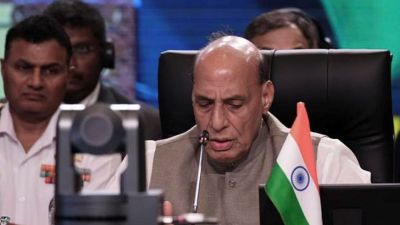Trouble in fantasia
Despite stray indications that the film business is assuming more finite, real and even corporate dimensions, precious little has changed. ...

Despite stray indications that the film business is assuming more finite, real and even corporate dimensions, precious little has changed. Like it or not, a method still has to be evolved for the madness of movie-making.
Fantasies— as opposed to themes rooted in ground reality—continue to be the fodder served to an increasingly demanding audience, be it in the age-old commodious cinema auditoria or the multiplexes sprouting in the metros.
Every new year, of for that matter every new month, the trade chiefs grouse that the ticket-buying public is rejecting mundane, moth-eaten yarns. It is admitted that an attitudinal shift is a must to woo back the audience which has shifted its allegiance to television soap operas and western chic beamed in via satellite channels.
Although quality consciousness is much in the air, stupor-inducing love stories, jawbreaking actioners and febrile family fandagos are hacked out at a rate which assures an annual production rate of nearly 200 films from the Mumbai studios alone.
The Telugu and Tamil film industries of Hyderabad and Chennai, individually contribute as many if not more products to the yearly harvest of 700-800, preserving the status of India as the prime film making country of the world.
Unarguably, it is the ‘Bollywood’ bonbons which tickle the palate of the homogenous national audience and in recent years, the taste buds of the Non-Resident Indian population in the U.S., U.K. and the Middle East.
If trouble in paradise is manifested in crashing box office receipts, another story is told by the undaunted activity in the studios and the ceaseless release of a new film or two every Friday.
And the story is that the gambling instinct presides stalwartly among the producers and directors. A majority of them believes that another whopper hit a la Sholay, Dilwale Dulhania Le Jayenge or Kuch Kuch Hota Hai is not beyond the realm of imagination. Prayers are sent up to the deities and the lord above for success, which is not surprising given the absolutely chancy scheme of things.
Yet cinema has become a stale buffet of sorts. At the risk of indigestion, gorge on the goodies. Tujhe Meri Kasam, was recently released. The film is a love story about two college friends who must shatter the platonic barrier, Bollywood Hollywood is a disappointingly vapid spoof of masala movie conventions by the Canada-based Deepa Mehta, and Talaash a senseless stunt picture which unashamedly asserted that popular cinema is getting from bad to thoroughly insane.
The last month of 2002 had buoyed up hopes with the premieres of Kaante and Saathiya. In vain. Both the excessively-publicised films were dissatisfying, the former for its disjointed, foul-mouthed tribute to American heist capers, and the latter for its slavish frame-to-frame transcription of the Tamil film Alaipayuthe.
What we need are Trojan horse films which break the rules while staying within the system. What we need are stronger and valid themes evidenced only once in a blue moon, as in Aparna Sen’s Mr and Mrs Iyer, which dwelt on a communal flare-up without getting didactic or self-congratulatory.
What we need are stories that have a beginning, middle and end, with either pure entertainment to offer or a pertinent point to make. Alas, the new genre of ‘Hinglish’ films frequently seems to be more intent in being different and trendy, retreading subjects like marital stress (Let’s Talk) and adolescent wet dreams (Leela), achieving at best, mediocre results.
To be sure Mira Nair’s Monsoon Wedding and Gurinder Chadha’s Bend it like Beckham have spawned the notion of ‘crossover’ films, meaning modestly-budgeted pictures whose appeal straddles continents.
However, instead of jumping onto this bend-wagon, film-makers at home need to note that cinema— plot lines, presentation and packaging— has to necessarily arise from a felt and experienced milieu. It would, indeed, be an exercise in futility if any of the India-rooted film makers suddenly donned Mira Nairesque robes.
Besides blatant imitation, the other factors which need to be discarded are certainly those irrelevant jaunts to foreign locations like Switzerland, wastage of finances caused by inordinate production delays and of course, more often than not, the absence of a script which is the central pillar of any film.
Moreover, the blind worship of top actors and actresses, fanned in no small measure by the fanzines, has to stop dictating the tenor and texture of what seems like 99 per cent of the films.
Stars do stoke the dreams and fantasies of the impressionable audience – and to be fair most of the artistes are more competent and creative than the films they appear in – but nowhere in the world is there such a crippling dependence on the star hierarchy. Audiences are willing to try the new and untested but the trade distributors and exhibitors have been irrevocably star-struck.
Over time, like the stars, popular cinema has firmly entrenched itself in the national psyche. But, alas, without any sense of responsibility. Frequently reprehensible values are peddled under the pretext of supplying no-holds-barred entertainment.
Vulgarity, the denigration of women and crude humour are rampant, aggravated by an archaic form of governmental censorship. For instance, since kissing or any semblance of nudity is strictly forbidden, film makers resort to subterfuge, innuendoes and double entendres that escape the censors’ scissors.
An enlightened form of censorship is as imperative as a sense of responsibility from film makers. News is that at least half a dozen films on the Kargil war are under production for release later this year.
While this is welcome in principle, the mind boggles at the prospect of getting snowed under jingoism and patriotism of the strident kind.
The primary ethic of cinema anywhere is to approximate the truth. It is when films speak with a forked tongue or hoodwink the audience, that they bite the dust.
One can only hope that the Mumbai-made cinema will get its act together, mirror the aspirations and anxieties of the spectator, instead of flying off into fantasies of no return.






- 01
- 02
- 03
- 04
- 05
























